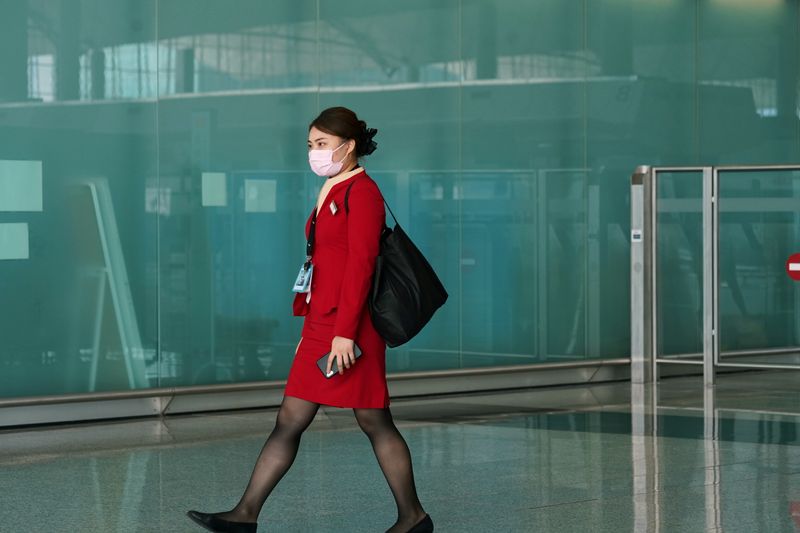
A Cathay Pacific employee, wearing a face mask following the coronavirus disease (COVID-19) outbreak, walks past the departures hall at Hong Kong International Airport in Hong Kong, China October 20, 2020. REUTERS/Lam Yik
October 21, 2020
By Jamie Freed
SYDNEY (Reuters) – Hong Kong’s Cathay Pacific Airways Ltd said on Wednesday it would slash 5,900 jobs and end its regional Cathay Dragon brand, joining peers in cutting costs as it grapples with a plunge in demand due to the coronavirus pandemic.
The airline would also seek changes in conditions in its contracts with cabin crew and pilots as part of a restructuring that would cost HK$2.2 billion ($283.9 million), it told the stock exchange.
Overall, it will cut 8,500 positions, or 24% of its normal headcount, but that includes 2,600 roles currently unfilled due to cost reduction initiatives, Cathay said.
“The global pandemic continues to have a devastating impact on aviation and the hard truth is we must fundamentally restructure the group to survive,” Cathay Chief Executive Augustus Tang said in a statement.
Cathay shares jumped almost 7% in early trade and were 4% higher at 0430 GMT, with broker Jefferies saying the announcement removed a key overhang on the stock.
Singapore Airlines Ltd and Australia’s Qantas Airways Ltd have already announced similarly large payroll cuts, as the International Air Transport Association forecasts passenger traffic will not recover until 2024.
Cathay, which has stored around 40% of its fleet outside Hong Kong, said on Monday it planned to operate less than 50% of its pre-pandemic capacity in 2021.
After receiving a $5 billion rescue package led by the Hong Kong government in June, it had been conducting a strategic review that analysts expected would result in major job losses.
The airline said it was bleeding HK$1.5 billion to HK$2 billion of cash a month and the restructuring would stem the outflow by HK$500 million a month in 2021, with executive pay cuts continuing throughout next year.
BOCOM International analyst Luya You said she had expected more strategic insight from the airline on its fleet plans and route network as part of the restructuring.
“Had they revealed more on fleet planning for 2021-22, we would get a much better sense of their outlook,” she said.
The decision to end regional brand Cathay Dragon is in line with rival Singapore Airlines’ pre-pandemic move to fold regional brand Silkair into its main brand.
Cathay Dragon, once known as Dragonair, operated most of the group’s flights to and from mainland China and had been hit by falling demand before the pandemic due to widespread anti-government protests in Hong Kong that deterred mainland travellers.
Plans to merge Cathay Dragon into Cathay’s main brand earlier this year hit roadblocks from China’s aviation regulator because of infractions during last year’s pro-democracy protests, two sources told Reuters in May.
Cathay said the airline would cease operating immediately and it would seek regulatory approval to fold the majority of Cathay Dragon’s routes in Cathay Pacific and low-cost arm HK Express.
In the short-term, the closure of the Cathay Dragon brand will result in it being unable to carry cargo to Fuzhou, Guangzhou, Kuala Lumpur and Fukuoka, and it will only send dedicated freighters to Xiamen, Chengdu and Hanoi, it told cargo customers in a memo, indicating the routes were cut for now.
“The reintroduction of service coverage will differ from port to port,” Cathay said.
Like Singapore Airlines, Cathay lacks a domestic market to cushion it from the fall in international travel due to border closures.
In September, Cathay’s passenger numbers fell by 98.1% compared with a year earlier, though cargo carriage was down by a smaller 36.6%.
Cathay shares have fallen 41% since the start of January.
The airline’s share register is dominated by Swire Pacific Ltd, Air China Ltd, Qatar Airways and the Hong Kong government, with only a 12% free float.
(Reporting by Jamie Freed; Editing by Stephen Coates)

